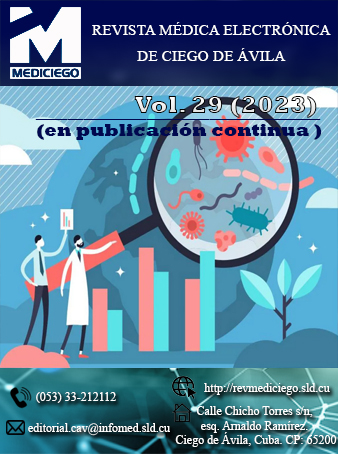System of didactic procedures for the teaching-learning of electrocardiography in the Medicine career
DOI:
https://doi.org/10.5281/zenodo.13797672Keywords:
electrocardiography, medical training, teaching materials, undergraduate medical educationAbstract
Introduction: the electrocardiogram is a complementary test of great clinical utility, but its interpretation is difficult for the medical student.
Objective: to evaluate the scientific-methodological relevance of the system of didactic procedures for the teaching-learning process of electrocardiography in the third year of the Medicine degree, based on its proposal as a practical construct.
Methods: a pedagogical research was carried out at the Faculty of Medical Sciences of Ciego de Ávila in the 2020-2022 triennium. The system of didactic procedures was elaborated from the relationships promoted from a previously constructed didactic conception. The hermeneutic-dialectical approach and the historical-logical, analytical-synthetic, abstraction-concretion, inductive-deductive and systemic-structural-functional methods were applied. The criteria of 16 experts using the Delphi consensus method with two rounds was used to assess its scientific-methodological relevance. Ethical principles were met.
Results: the two procedures, understanding and explanation of the cardiac cycle and appropriation of basic knowledge for the interpretation of electrocardiograms, are integrated into a system with components, structure, functions and hierarchy. Strengths and weaknesses, general objective, methodological guidelines, specific objectives and actions for each procedure and a control and evaluation system were determined. According to the methodological sequence of the Delphi method, a consensus was obtained with all the aspects evaluated as very adequate and statistically significant results.
Conclusions: the scientific-methodological relevance of a system of flexible didactic procedures, with interdisciplinary and investigative actions, based on its proposal as a practical investigative result, was verified by expert criteria.
Downloads
References
Gutiérrez-Maydata A, Rodríguez-Niebla KL, López-Castellanos D, Alfonso-Arbeláez LE, Méndez Cruz IM, Jacinto Hernández LE. Percepción de los estudiantes de la carrera de Medicina sobre su formación profesional. EDUMECENTRO [Internet]. 2020 [citado 12 Ago 2022];12(3):182-202. Disponible en: http://scielo.sld.cu/scielo.php?script=sci_arttext&pid=S2077-28742020000300182
Pérez-Bada E, Quintana-López LA. Evaluación del desarrollo de habilidades clínicas en estudiantes de 3er año de Medicina, Villaclara. EDUMECENTRO [Internet]. 2020 [citado 12 Ago 2022];10(2):[aprox. 9 p.]. Disponible en: http://scielo.sld.cu/scielo.php?script=sci_arttext&pid=S2077-28742018000200005
Lara-Prado JI. El electrocardiograma: una oportunidad de aprendizaje. Rev Facultad Medicina (México) [Internet]. 2016 [citado 4 Ago 2022];59(6):39-42. Disponible en: http://www.scielo.org.mx/scielo.php?script=sci_arttext&pid=S0026-17422016000600039&lng=es&tlng=esguardiola
Zavala-Villeda JA. Descripción del electrocardiograma normal y lectura del electrocardiograma. Rev Mex Anest [Internet]. 2017 [citado 12 Dic 2021];40(Suppl 1):S210-S13. Disponible en: https://www.medigraphic.com/pdfs/rma/cma-2017/cmas171bj.pdf
Apaza-Ramos JL. Conocimientos sobre la interpretación del electrocardiograma en los internos de medicina de la universidad Ricardo Palma en el año 2020 [Internet]. Lima-Perú: Universidad Ricardo Palma; 2021 [citado 12 Dic 2021]. Disponible en: http://repositorio.urp.edu.pe/bitstream/handle/URP/3914/T030_76124351_T%20%20%20APAZA%20RAMOS%20JANET%20LIZZETT.pdf?sequence=1&isAllowed=y
Bouza-Jiménez Y, Milián-Vázquez P, López-Rodríguez RM, Acosta-Figueredo E. El proceso de enseñanza aprendizaje de la electrocardiografía en la carrera de medicina. Medisur [Internet]. 2020 [citado 9 Nov 2021];18(4):591-604. Disponible en: https://www.medigraphic.com/pdfs/medisur/msu-2020/msu204i.pdf
González-Aguilera JC, Muñoz-Farto A, Fonseca-Muñoz JC. Propuesta didáctica para el desarrollo del sistema de clases de electrocardiografía en la asignatura Propedéutica Clínica. RM [Internet]. 2013[citado 13 Ago 2022];17(1):1-13. Disponible en: http://www.revmultimed.sld.cu/index.php/mtm/article/view/109
Fuentes HC, Matos EC, Cruz SS. El proceso de investigación científica desde un pensamiento dialéctico hermenéutico. Centro de Estudios de Educación Superior “Manuel F. Gran”. Universidad de Oriente. Santiago de Cuba; 2004.
Hurtado de Mendoza-Fernández S. Criterios de expertos. Su procesamiento a través del método Delphi. Barcelona: Universidad de Barcelona [citado 20 Dic 2020]. Disponible en: http://www.ub.edu/histodidactica/index.php?opcion=concontent/&view=article&id=21:criterio-d-expertos-su-procedimiento-a-traves-del-metodo-delphi&catid=11:metodología-y-epistemologia&lcemid=103
Asociación Médica Mundial. Declaración de Helsinki de la Asociación Médica Mundial. Principios éticos para las investigaciones médicas en seres humanos. Ratificada en la 64ª Asamblea General, Fortaleza, Brasil, octubre; 2013. [citado 30 ene 2021];[aprox. 4 pantallas]. Disponible en: https://declaracion-de-helsinki-de-la-amm-principios-eticos-para-las-investigaciones-medicas-en-seres-humanos.pdf
De Armas-Ramírez N, Lorences-González J, Perdomo-Vázquez JM. Caracterización y diseño de los resultados científicos como aportes de la investigación educativa. Villa Clara: Universidad Pedagógica “Félix Varela”; 2003 [citado 19 Feb 2020] Disponible en: http://files.especializacion-2012.webnode.com.co/200000152-80d3f81ccc/CARACTERIZACI%C3%93N%20Y%20DISE%C3%91O%20DE%20LOS%20RESULTADOS%20CIENT%C3%8DFICOS%20COMO%20APORTES%20DE%20LA%20INVESTIGACI%C3%93N%20EDUCATIVA.pdf
Arévalo-Pérez L, Sori-Peña JA, Pérez-García ER. EKGUÍA, software educativo sobre la interpretación del electrocardiograma [Internet]. La Habana: AVS; 2020 [citado 4 Ago 2022]. Disponible en: http://aulavirtual.sld.cu/pluginfile.php/44343/mod_data/content/10397/EKGUIA.pdf
Ministerio de Salud Pública (Cuba). Universidad de Ciencias Médicas de la Habana. Plan de estudio E para la carrera de Medicina. La Habana: MES; 2019.
Vento-Pérez RA, Hernández-Rodríguez Y, León-García M. Video del procedimiento de realización de un electrocardiograma [Internet]. Holguín: CENCOMED; 2019 aprox. 15 p.]. Disponible en: http://edumedholguin2019.sld.cu/index.php/2019/2019/paper/view/309/199
Valcárcel-Izquierdo N, Díaz-Díaz AA. Epistemología de las ciencias de la educación médica: sistematización cubana. 1ra ed. La Habana: Editorial Ciencias Médicas; 2021 [Internet]. [citado 12 Ago 2022]. Disponible en: http://bvs.sld.cu/libros/epistemologia_ciencias_educacion_medica/epistemologia_ciencias_educacion.pdf
Viced-Tomey A, Miralles-Aguilera E. Sobre la naturaleza del conocimiento médico y su enseñanza (Parte I). Educ Méd Sup [Internet]. 2022 [citado 12 Ago 2022];36(1):e3297. Disponible en: http://scielo.sld.cu/ scielo.php?script=sci_arttext&pid=S0864-21412022000100016
Published
How to Cite
Issue
Section
License
Copyright (c) 2023 Aymé Alberna Cardoso

This work is licensed under a Creative Commons Attribution-NonCommercial 4.0 International License.
Those authors who have publications with this journal accept the following terms of the License CC Attribution-NonCommercial 4.0 International (CC BY-NC 4.0):
You are free to:
- Share — copy and redistribute the material in any medium or format
- Adapt — remix, transform, and build upon the material
- The licensor cannot revoke these freedoms as long as you follow the license terms.
Under the following terms:
- Attribution — You must give appropriate credit , provide a link to the license, and indicate if changes were made . You may do so in any reasonable manner, but not in any way that suggests the licensor endorses you or your use.
- NonCommercial — You may not use the material for commercial purposes .
- No additional restrictions — You may not apply legal terms or technological measures that legally restrict others from doing anything the license permits.
Notices:
You do not have to comply with the license for elements of the material in the public domain or where your use is permitted by an applicable exception or limitation .
No warranties are given. The license may not give you all of the permissions necessary for your intended use. For example, other rights such as publicity, privacy, or moral rights may limit how you use the material.

























